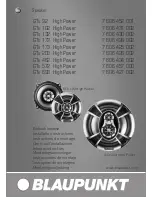
16
12. System Configurations & OEM Controllers
Passive or Biamp?
The iQ 10/15 is supplied as standard for bi-amp operation, therefore there is no
internal passive crossover network between the LF & Mid/High units.
The Bi-amp
controller parameters below must be adhered to for optimum performance.
An optional iQ 10/15 (tri-amp version) can be ordered.
A loudspeaker driven in Bi-amp mode offers a number of performance advantages,
such as increased system headroom. Audio program materiel is made up of many
different frequencies and harmonics. In music materiel, most of the energy is in the
low frequencies, with less in the highs. When both high and low frequencies are
present in a signal, the stronger low frequencies can use up amp power, leaving little
or no reserve for the highs, so they are more likely to cause the power amplifier to
clip. In a Biamp driven system, a smaller amp can handle high frequencies, LF amp
clipping is less of a factor, and less overall amplifier capacity is needed due to the
efficiency improvement in the absence of a passive crossover.
Bi-amp System Parameters (iQ 10/15)
Parameter
Unit/Name
Low Section
Mid/High Section
Gain
(dB) +5
0
Delay*
(ms) 0
0
Polarity
Positive
Positive
HPF
Freq (Hz)
39.8
180
Slope (dB/oct)
24
24
Filter Shape
Butterworth
Linkwitz Riley
LPF
Freq (Hz)
180
Thru
Slope (dB/oct)
24
NA
Filter Shape
Linkwitz Riley
NA
Freq (Hz)
60.1
2000
Level (dB)
+4
-4
Type Parametric
Parametric
PEQ 1
Q / Bandwidth
2 / 0.5
0.8 / 1.25
Freq (Hz)
141.3
Level (dB)
-5
Type Parametric
PEQ 2
Q / Bandwidth
2 / 0.5
Summary of Contents for Power Dual iQ 15
Page 1: ...iQ SERIES USER MANUAL iQ 10 15...
Page 2: ......
Page 7: ...8 Dimensions 1116 0 680 0 540 0 7...
Page 11: ...Typical Suspension Truss applications 2 x iQ 10 15 2 x iQ 10C 2 x iQ 10 15 11...
Page 19: ......





































